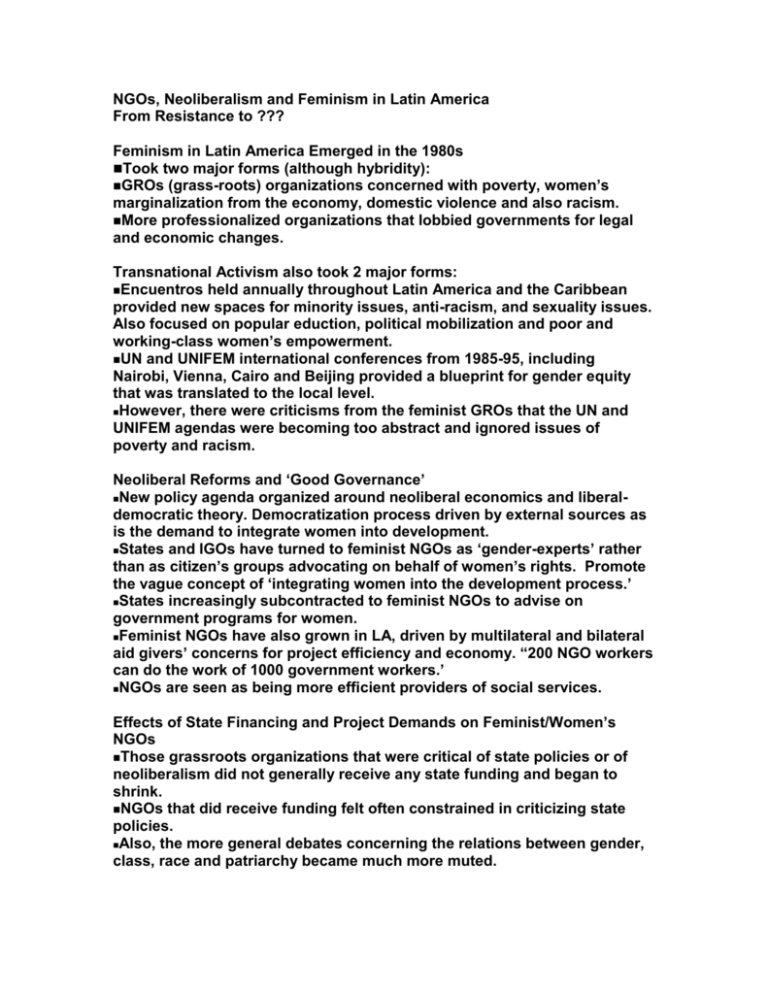NGOs and Feminism in Latin America
advertisement

NGOs, Neoliberalism and Feminism in Latin America From Resistance to ??? Feminism in Latin America Emerged in the 1980s Took two major forms (although hybridity): GROs (grass-roots) organizations concerned with poverty, women’s marginalization from the economy, domestic violence and also racism. More professionalized organizations that lobbied governments for legal and economic changes. Transnational Activism also took 2 major forms: Encuentros held annually throughout Latin America and the Caribbean provided new spaces for minority issues, anti-racism, and sexuality issues. Also focused on popular eduction, political mobilization and poor and working-class women’s empowerment. UN and UNIFEM international conferences from 1985-95, including Nairobi, Vienna, Cairo and Beijing provided a blueprint for gender equity that was translated to the local level. However, there were criticisms from the feminist GROs that the UN and UNIFEM agendas were becoming too abstract and ignored issues of poverty and racism. Neoliberal Reforms and ‘Good Governance’ New policy agenda organized around neoliberal economics and liberaldemocratic theory. Democratization process driven by external sources as is the demand to integrate women into development. States and IGOs have turned to feminist NGOs as ‘gender-experts’ rather than as citizen’s groups advocating on behalf of women’s rights. Promote the vague concept of ‘integrating women into the development process.’ States increasingly subcontracted to feminist NGOs to advise on government programs for women. Feminist NGOs have also grown in LA, driven by multilateral and bilateral aid givers’ concerns for project efficiency and economy. “200 NGO workers can do the work of 1000 government workers.’ NGOs are seen as being more efficient providers of social services. Effects of State Financing and Project Demands on Feminist/Women’s NGOs Those grassroots organizations that were critical of state policies or of neoliberalism did not generally receive any state funding and began to shrink. NGOs that did receive funding felt often constrained in criticizing state policies. Also, the more general debates concerning the relations between gender, class, race and patriarchy became much more muted. Gender ‘integration’ became seen as a merely technical matter, e.g. job training or micro-finance circles. Wider political debates on advocacy for poor women and the reasons for their marginalization are discouraged. NGOs growing contractual relationship with the state and international funders compromises their effectiveness in advocating feminist reforms of societies. Conclusions Another example in which what began as an autonomous movement has become, to some extent, shaped by external sources of funding. A discourse of State and civil society’s ‘co-responsibility’ for social welfare has pre-empted much of the former critical edge of Latin American feminism. Feministas autonomas, a relatively small but vocal political current, has emerged that criticizes NGO institutionalization, seeing it as selling out to ‘neoliberal patriarchy’. Alvares: radical edge of feminism has been blunted, but many in NGOs try to maintain both a critical edge as well as their more technical, service provisions.









